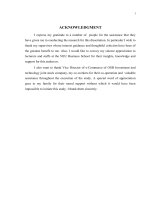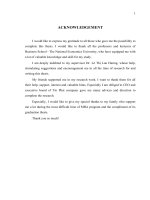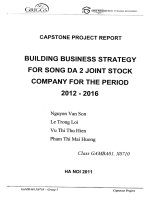Strategic developmentof joint stock company for telecom and informatics in period 2011 - 2015
Bạn đang xem bản rút gọn của tài liệu. Xem và tải ngay bản đầy đủ của tài liệu tại đây (1.47 MB, 97 trang )
CAPSTONE PROJECT REPORT
STRATEGIC DEVELOPMENT
OF JOINT STOCK COMPANY FOR
TELECOM AND INFORMATICS
IN PERIOD 2011 - 2015
Nguyen Xuan Hoang
Pham Cong Khanh
Nguyen Quoc Khanh
Mai Huong Lan
2011
GLOBAL ADVANCED MBA PROGRAM (GaMBA.C0 4)
Group No.: 2
Class: GaMBA01.C0409
Ho Chi Minh City, 2011
GLOBAL ADVANCED MASTER OF
BUSINESS ADMINISTRATION PROGRAM
CAPSTONE PROJECT REPORT
STRATEGIC DEVELOPMENT
OF JOINT STOCK COMPANY FOR
TELECOM AND INFORMATICS
IN PERIOD 2011 - 2015
Group Number: 02
Student's name:
Nguyen Xuan Hoang
Pham Cong Khanh
Nguyen Quoc Khanh
Mai Huong Lan
HO CHI MINH CITY, 2011
C04.Strategic Management.Capstone Project Report.Group 2
1
TABLE OF CONTENTS
TABLE OF CONTENTS 1
LIST OF ABBREVIATIONS 4
LIST OF TABLES 6
LIST OF FIGURES 7
FOREWORD 8
CHAPTER 1. THEORY OF BUSINESS STRATEGY 10
1.1 The concept of business strategy planning 10
1.1.1 The concept of strategic management 10
1.1.2 The role of the strategic management 10
1.2 Classification of business strategies 11
1.2.1 Specific kinds of strategies 11
1.2.2 Viewpoint of Michael Porter on typical strategies 13
1.3 The strategic planning process 14
1.4 External environment analysis 15
1.4.1 Macro-environment 15
1.4.2 Analysis of industry environment (micro-environment) 17
1.5 Internal environment analysis 19
1.6 SWOT analysis 19
1.7 Strategy Selection Matrix 19
1.7.1 Grand strategy matrix 19
1.7.2 Industry analysis: External factor evaluation matrix (EFE) 20
1.7.3 Industry analysis: Competitive Profile Matrix (CPM) 21
1.7.4 Industry analysis: Internal Factor Evaluation Matrix (IFE) 21
1.7.5 SWOT matrix 22
1.7.6 The Strategic Position and Action Evaluation matrix (SPACE) 23
1.7.7 Internal - External Factor Matrix (IE) 25
C04.Strategic Management.Capstone Project Report.Group 2
2
1.7.8 Quantitative Strategic Planning Matrix (QSPM) 25
CHAPTER 2. BUSINESS OPERATION OF JOINT STOCK COMPANY FOR
TELECOM AND INFORMATICS (CT-IN) 26
2.1 Introduction of Vietnam Posts and Telecommunications Group (VNPT) 26
2.1.1 Overall view of VNPT 26
2.1.2 Business scope – key products/services: 27
2.1.3 Organizational structure of VNPT 28
2.2 Introduction of CT-IN 29
2.2.1 Company history 29
2.2.2 Functions and missions of CT-IN 30
2.2.3 Organizational structure of CT-IN 32
2.2.4 Existing customer base and partners 33
2.2.5 Business performance of CT-IN within 3 recent years (2008 to 2010) 34
2.3 Analysis of internal environment of CT-IN 41
2.3.1 Management 41
2.3.2 Marketing 43
2.3.3 Finance – Accounting 43
2.3.4 Production 44
2.3.5 Research and development 44
2.3.6 The information system 44
2.4 Analysis of external factors affecting 44
2.4.1 Analysis of macro environment 44
2.4.2 Analysis of Industry environment 48
2.4.3 Analysis of competitors 60
CHAPTER 3. DEVELOPMENT STATEGY OF CT-IN IN THE 2011 – 2015
PERIOD 63
3.1 The development orientation of Vietnam’s ICT industry by 2020 63
3.2 Integrated managed services and Opportunities for CT- IN 65
3.2.1 Integrated managed service 65
C04.Strategic Management.Capstone Project Report.Group 2
3
3.2.2 Successful models in the regional countries 67
3.2.3 Opportunities for CT-IN 69
3.3 Objectives of CT-IN in period of 2011 - 2015 71
3.3.1 Long-term objectives up to 2015 71
3.3.2 Specific annual objective in 2011 - 2015 period 71
3.4 Strategy Selection Matrix 72
3.4.1 External factor evaluation (EFE) matrix 72
3.4.2 Competitive Profile Matrix (CPM) 73
3.4.3 Internal factor evaluation (IFE) matrix 74
3.4.4 SWOT Matrix analysis 75
3.4.5 The Strategic Position and Action Evaluation matrix (SPACE) 78
3.4.6 Internal – External Matrix (IE) 81
3.4.7 Preliminary strategy selection 81
3.4.8 Quantitative Strategic Planning Matrix (QSPM) 82
3.5 Strategy implementation 86
3.5.1 Differentiation strategy 86
3.5.2 Product development strategy 87
3.5.3 Market Development strategy 87
3.5.4 Market Penetration 88
3.5.5 Marketing and PR strategy 89
3.5.6 Human Resource Management strategy 91
3.6 Strategy review and evaluation 91
3.7 Recommendations 92
CONCLUSION 93
REFERENCES 94
C04.Strategic Management.Capstone Project Report.Group 2
4
LIST OF ABBREVIATIONS
ADSL Asymmetric Digital Subscriber Line
AS Attractiveness score
BRAS Broadband Remote Access Server
BSC Base Station Controller
BSS Business support systems
BTS Base Transceiver Station
CAGR Compound Annual Growth Rate
CIBAS Intelligent Building Automation Solutions
CMC Computer Telecommunication Limited Company
CPI Consumer Price Index
CRM Customer relation management
CT-IN Joint Stock Company for Telecoms and Informatics
DSLAM Digital Subscriber Line Access Multiplexer
ERP Enterprise Resource Planning
EVN Electricity of Vietnam
FPT the Corporation for Financing and Promoting Technology
GSO General Statistics Office
HW/SW Hardware/Software
IBS Intelligent Building Solution
ICT Information and Communication Technologies
IMT2000/3G the 3rd generation mobile communication standard of ITU,
IMT stands for "International Mobile Telecommunications"
C04.Strategic Management.Capstone Project Report.Group 2
5
ISPs Internet Services Providers
ITU International Telecommunication Union
KASATI Telecom - Informatics - Electronics JSC
KPI Key performance indicators
MAN Metro Area Network
MS Managed Services
MSC Mobile Service Center
MSP Managed Services Provider
NGN Next Generation Network
OEM Original Equipment Manufacturers
PPP Purchasing Power Parity
SBV the State Bank of Vietnam
SLA Service Level Agreement
SMS Short Message Service
TAS Total attractiveness score
TST Technical Services Telecom JSC
VAS Content and Value-added services
VMS Vietnam Mobile Telecom Service Company (the brand MobiFone)
VNPT Vietnam Posts and Telecommunication Group
WiMAX Worldwide Interoperability for Microwave Access
C04.Strategic Management.Capstone Project Report.Group 2
6
LIST OF TABLES
Tables 1.1. Strategy formulation process 20
Tables 1.2. External factor evaluation matrix (EFE) 20
Tables 1.3. Competitive Profile Matrix 21
Tables 1.4. Internal Factor Evaluation Matrix (IFE) 21
Tables 1.5. SWOT matrix 22
Tables 1.6. Matrix of Strategic Position and Action Evaluation (SPACE) 23
Tables 1.7. Quantitative Strategic Planning Matrix (QSPM) 25
Tables 2.1. Business performance of CT-TN from Y2008 to Y2010 34
Tables 2.2. Analyzing changes in balance sheet of CT-IN during Y2008 – Y2010 35
Tables 2.3. Status of revenues and profits from 2006 to 2010 38
Tables 2.4. Analysis of some basic financial indicators 39
Tables 3.1. Targeted revenue of each year from 2011 to 2015 71
Tables 3.2. External factor evaluation matrix 72
Tables 3.3. Competitive Profile Matrix 73
Tables 3.4. Internal factor evaluation matrix 74
Tables 3.5. SWOT matrix 76
Tables 3.6. The Strategic Position and Action Evaluation matrix (SPACE) 78
Tables 3.7. Internal – External Matrix (IE) 81
Tables 3.8. Recommended strategies of each kind of matrix 81
Tables 3.9. The matrix to select the strategies (1/2) 82
Tables 3.10. The matrix to select the strategies (2/2) 84
C04.Strategic Management.Capstone Project Report.Group 2
7
LIST OF FIGURES
Figures 1.1. Comprehensively strategic management model of Fred R.David 14
Figures 1.2. Factors impacting the macro-environment 15
Figures 1.3. M. Porter five-force model 17
Figures 1.4. SPACE matrix 24
Figures 2.1. Organizational chart of VNPT Group 28
Figures 2.2. Organizational chart of CT-IN 32
Figures 2.3. Charts the development of CT-IN 38
Figures 2.4. GDP growth on the monthly basis during 2008-2010 45
Figures 2.5. Month-on-month inflation rate in 2010 46
Figures 2.6. The number of Internet-users in the world 49
Figures 2.7. Managed Services market drivers 55
Figures 2.8. The circle of Managed Services growth 57
Figures 3.1. Managed Services structured from a scope and reward perspective 67
Figures 3.2. SPACE matrix diagram of CT-IN 80
C04.Strategic Management.Capstone Project Report.Group 2
8
FOREWORD
The Information and Communications Technology (ICT) is a crucial driver to the
sustainable development and growth of our country, transparency improvements in
the activities of state agencies, the saving of time and expenditure of agencies,
organizations, enterprises and inhabitants. The Project of "Turning Vietnam into a
strong ICT country” approved by the Government is considered to be a “gold
opportunity” for foreign and local enterprises/or incorporations to invest in the ICT
industry.
The ICT sector of Vietnam is a dynamic market bringing not only great potentials
but also many challenges to ICT solution and service providers. Telecommunication
- Computing - Post Joint Stock Company (also called Joint Stock Company for
Telecom and Informatics or CT-IN) belonging to General Post Office (currently
called Vietnam Post and Telecommunications Corporation - VNPT) has nearly 40
years of experience in the ICT industry and is one of the leading ICT-related
product/service suppliers in Vietnam.
Through the analysis of the current condition of the socio-economy and ICT
industry in Vietnam, and of CT-IN’s business performance of, we would like to
contribute to the Company some recommendations about development strategies in
the 2011 - 2015 periods.
Objectives and applicability of the research
The main objective of the thesis is to build up the development strategy for CT-IN
from 2011 to 2015 (the period in which integrated managed services and mobile
broadband technology are expected to develop strongly). With its many-year
experiences in the ICT industry, CT-IN will take advantage of this opportunity to
develop more diversified service/product packages to meet the market demand.
C04.Strategic Management.Capstone Project Report.Group 2
9
Research methodology:
We use both qualitative and quantitative approaches. Besides, the thesis is herein
based on a market research data collection, ICT experts’ viewpoints, forecasts about
the demand and growth rate of the ICT industry, and is referred to some successful
integrated managed service models in regional countries and in the world.
The data used in this thesis is partially provided by CT-IN and published on
websites of authorities (i.e. General Statistics Office, Ministry of Information &
Communications, and VNPT) or the ones specialized in ICT.
Thesis structure: includes 03 chapters as below:
Chapter 1: Introduces the fundamental theories of building up strategies related
to the research scope.
Chapter 2: Analyzes the current business performance of CT-IN
Chapter 3: Builds up a development strategy for CT-IN in the period from 2011
to 2015; accordingly, it focuses on the model of integrated managed services.
C04.Strategic Management.Capstone Project Report.Group 2
10
CHAPTER 1. THEORY OF BUSINESS STRATEGY
1.1 THE CONCEPT OF BUSINESS STRATEGY PLANNING
1.1.1 The concept of strategic management
The strategy is often considered to be a “product” of a rational planning process
which is led by senior executives, but not everything. In many cases, valuable
strategies can arise even from the inside of the company, but without anything
planned in advance.
The strategic management is a set of management decisions and actions to
determine long-term performance of a company. The strategic management
includes continuous actions such as internal and external environmental review,
strategy construction, strategy implementation, and strategy control and assessment.
Therefore, the strategy research focuses on the monitoring and assessment of
external opportunities and threats that a company will potentially face by its internal
strengths and weaknesses.
The strategic management originates from business policies and long-term
projection. However, contrary to the strategic management, business policies aim at
the general management orientation and focus on the integration of internal
departments’ functions. Meanwhile, the strategic management focuses on not only
inside elements but the environment and strategy as well
1
. Therefore, the term
“strategic management” is commonly used instead of “business policy”.
1.1.2 The role of the strategic management
The strategic management and build-up help enterprises:
- To fulfill long-term objectives of the company sustainably;
1
R.E. Hoskisson, M.A. Hitt, W.P.Wan, and D.Yiu, (1982), “Theory and Research in Strategic Management:
Swings of the Pendulum”, Journal of Business. Vol25, No.3, pp 417-456
C04.Strategic Management.Capstone Project Report.Group 2
11
- To dominate the market or market segment in which the company is doing
business; and to determine business tactics which should be applied in the
coming time;
- To identify how to dominate market segments (with respect to each specific
targeted customer group) in comparison with its competitors;
- To identify what resources should be used (human, skills, property, finance,
know-how, etc ) to fulfill the goal;
- To determine potential external risks/ threats that may possibly affect the
strategy implementation (i.e. environment, competition, politics, natural
resources); and to come up with risk mitigation plans; and
- To determine the values that the company will bring to end-users and the whole
society;
1.2 CLASSIFICATION OF BUSINESS STRATEGIES
1.2.1 Specific kinds of strategies
According to Fred R. David, strategies can be classified into 14 specific types and
categorized into four groups as follows:
1.2.1.1 Integrative strategies
- Forward integration is related to increasing the ownership or control over
distributors or retailers. An efficient way to implement the forward integration
strategy is the franchise model. Enterprises may possibly grow rapidly with
franchise business model in which the cost and opportunities will be shared to
many individuals.
- Backward integration is related to looking for the ownership or control of the
company's suppliers. This strategy particularly makes sense in case that the
existing suppliers of the company are unreliable or incapability of satisfying
requirements of the company.
C04.Strategic Management.Capstone Project Report.Group 2
12
- Horizontal integration is related to finding out the ownership or control over
competitors. The merger, acquisition and domination of the control power over
competitors possibly enable the company to enhance the efficiency and the
exchange of resources.
1.2.1.2 Intensive strategies
- Market penetration: Pushing up the market share of existing products/ services
by intensifying marketing and promotion programs; the market penetration
strategy includes rises in the number of salespersons, advertising costs, and
promotional products or advertising efforts.
- Market development: Introducing the existing products and services in new
regions/markets;
- Product development: Pushing up the sales by renovating or modifying the
existing products or services; As usual, research and development (R&D) costs
are quite high.
1.2.1.3 Expansion strategy
- Concentric diversification: Launching new products or services which are
related to each other;
- Horizontal diversification: Offering to existing customers new products or
services which are not related to each other;
- Conglomerate diversification: Launching new products or services which are
not related to each other;
1.2.1.4 Other strategies
- Joint Venture and/or Alliance: Being an independent company which is founded
from two or more sponsoring firms for the purpose of cooperation;
- Turnaround: A turnaround strategy is designed to reverse a negative trend and
get the organization back on the track to profitability. Turnaround strategies usu-
C04.Strategic Management.Capstone Project Report.Group 2
13
ally try to reduce operating costs, either by cutting "excess fat" and operating
more efficiently or by reducing the size of operations;
- Divestment: Divestment involves selling off a part of the business, which can be
a SBU, a product line, or a division;
- Liquidation: Selling all assets separately at their tangible value;
- Simultaneous: Pursuing two or more strategies simultaneously;
1.2.2 Viewpoint of Michael Porter on typical strategies
According to Porter, specific strategies give the company competitive advantages
from three different drivers:
- Targeting at the cost-price (low-cost strategy): Producing standardized products
at the low unit cost to serve price-sensitive customers;
- Differentiation: Producing typical products/ services of the industry to serve
customers who are insensitive to price;
- Focusing on key points: Producing products/ services that meet needs of a small
group of customers;
A key reason for pursuing the forward/or backward/ or horizontal integration
strategy is to take benefits from the cost-oriented production;
Product development is a specific strategy to facilitate the Company to make
product differentiation. Making the product differentiation successfully means to
enhance the flexibility and function synthesizing of the products, to lower costs, to
improve service quality, reduces maintenance cost and time, and offers more
convenience to customers;
Market penetration and market development strategies drive many centralized
advantages.
C04.Strategic Management.Capstone Project Report.Group 2
14
1.3 THE STRATEGIC PLANNING PROCESS
According to Fred R.David, the strategic management process comprises three
phases, namely strategy formulation, strategy implementation and strategy
evaluation.
Vision &
Mission
Statements
Adjust
entrepreneur’
s business
mission
External Audit
Internal Audit
Long-Term
Objectives
Generate,
Evaluate, Select
Strategies
Annual
Objectives
Allocating
resources
Management
Issues
Measure and
Evaluate
Performance
Feedback
Formation Strategies Implement Strategies
Evaluate
Strategies
Feedback
Source: Strategic Management and Business Policy, 11th Edition
Figures 1.1. Comprehensively strategic management model of Fred R.David
Strategy formulation is a process of setting business tasks and doing researches/
surveys in order to determine internal and external drawbacks, to define long-rum
objectives and to pick out alternative strategies. This phase is sometimes also
known as "strategic planning" including three basic tasks such as doing research,
intuitive integration and analysis, and decision-making.
Strategy implementation (also called the action stage of the strategic management)
is to mobilize administrators and staffs to implement the given strategies. Three
basic activities of the strategy implementation are to set annual goals, to put forward
policies and to distribute resources. This stage is considered to be the most difficult
in the strategic management process.
C04.Strategic Management.Capstone Project Report.Group 2
15
Strategy evaluation is the ending stage of the strategic management. All strategies
depend on changes in the future because all internal and external factors change
regularly. Three main activities of this phase are to determine what elements are the
base for the current strategy, to measure achievements and (3) to make adjustments.
1.4 EXTERNAL ENVIRONMENT ANALYSIS
1.4.1 Macro-environment
The external environment comprises all external factors which cannot be controlled
by business managers but have great influence to the objective fulfillment, growth
and profitability of each company. The analysis of the external environment
includes macro-environment and industry analysis. The analysis of these factors
helps enterprises to identify their market position, and environmental characteristics
and the era at which they are present, to determine influences of the external
environment on business, and thereby to make relevant decisions.
Source:
Strategic Management, Session 1- part 1
Figures 1.2. Factors impacting the macro-environment
C04.Strategic Management.Capstone Project Report.Group 2
16
Macro-environmental changes possibly influence directly on any forces in the
industry, which results in changes in relative strengths of these forces and in
attractiveness of the industry. The macro-environment consists of six factors,
namely economic, socio-cultural, demographic, political, legal, technological and
global elements.
- Economic elements
Economic elements include the growth rate and stability of the economy,
purchasing power, price stability, monetary, inflation, foreign exchange rate, etc
These factors all affect business activities of enterprises.
- The socio-cultural factors:
The social characteristics are also the concern of enterprises as they do market
research. These social factors will split the community into customer groups, each
of which has different characteristics, psychology and income; for example:
Life expectancy, health status, nutrition, diet;
Average personal income, income distribution;
Lifestyle, knowledge, aesthetic viewpoint, psychological life;
Living conditions;
- Demographic factors
Including issues related to population, age structure, geographic distribution, ethnic
communities and income distribution;
- Political and legal factors:
The political stability;
Tax policy;
The laws/ legal regulations and trade policies;
C04.Strategic Management.Capstone Project Report.Group 2
17
- Technological factors
The technological factors include new production methods, new techniques, new
materials, production equipment, know-how, inventions, application software; etc
- Integration factor:
The globalization and integration trend forces local firms to take international
factors into account when they plan a long-term business strategy for themselves
which is highly integrative and capable of reaching the geographic scope and
politics.
1.4.2 Analysis of industry environment (micro-environment)
According to Mr. Michael Porter, five forces orienting the competition within the
sector are (1) threats of new entrants, (2) rivalry among existing players, (3)
bargaining power of buyers, (4) bargaining power of suppliers; (5) threat of
substitute products/ or services.
Source:
Strategic Management, chapter 3(concept 03)
Figures 1.3. M. Porter five-force model
C04.Strategic Management.Capstone Project Report.Group 2
18
- Bargaining power of suppliers is expressed by:
The quantity and scale of suppliers;
Capacity of producing substitute products/services;
Information about suppliers;
- Bargaining power of buyers
Customers are categorized into two groups, namely end-users and distributors. Both
groups put pressure on enterprises (in terms of price, product quality and enclosed
services); besides, they can impact on the competition in the industry with their
purchasing decisions.
- Competition pressure from new entrants
According to M-Porter, potential rivals are firms who currently have no presence in
the market but may affect the industry in future.
- Threats of substitute products
Substitute products and services are the ones having the same ability to satisfy
customers’ needs as that of existing ones.
- Rivalry among existing firms in the industry
Firms operating in the same sector will compete directly with each other, which in
its turn put pressure on the industry and enhance competitive intensity. In any
sector, the following factors will increase the competitive pressure on rivals:
Status of industry
Structure of industry
C04.Strategic Management.Capstone Project Report.Group 2
19
1.5 INTERNAL ENVIRONMENT ANALYSIS
In order to survive and develop, all organizations must conduct the following tasks:
management and administration, finance, accounting, manufacturing, trading,
professional executing, R&D, marketing, and building up an information system. In
each activity, each organization has its own strengths and weaknesses.
Internal environment analysis is an important and indispensable part of the strategic
management. If the management team does not analyze the internal environment or
cannot recognize strengths and weaknesses of the company exactly, they cannot set
a perfect strategy.
1.6 SWOT ANALYSIS
The SWOT analysis is to analyze the external environmental factors (opportunities
and threats) as well as inside elements (strengths and weaknesses) of the firm.
The firm identifies opportunities and threats through analyzing environmental
changes (in terms of the economic, financial, political, legal and social elements,
and competition level of the markets where they are operating or intend to entry.
With the internal environment analysis, strengths of the firm (related to his/or her
skills, resources and competitive advantages). The weaknesses of the firm are
reflected in the shortcomings related to skills, resources or other factors limiting
his/or her competitiveness.
1.7 STRATEGY SELECTION MATRIX
1.7.1 Grand strategy matrix
According to Fred R. David, the strategy formulation process includes three stages,
namely input stage, matching stage and decision stage.
C04.Strategic Management.Capstone Project Report.Group 2
20
Tables 1.1. Strategy formulation process
Phase 1: Input stage
External factors
evaluation matrix
(EFE)
Competitive Profile Matrix
Internal Factor
Evaluation Matrix (IFE)
Phase 2: Matching stage
Matrix of strengths –
Weaknesses –
Opportunities –
Threat (SWOT)
The Strategic
Position and Action
Evaluation matrix
(SPACE)
Matrix of
Boston
Consulting
Group
(BCG)
Internal-
External
matrix
(IE)
Grand
strategy
matrix
Phase 3: Decision stage.
Quantitative Strategic Planning Matrix (QSPM)
From the current situation of CT-IN, we mainly focus on the EFE and IFE matrix in
the input stage, SPACE and SWOT matrix in the matching stage to form strategies
of CT-IN, and QSPM matrix in the decision stage to pick out an appropriate
strategy for CT-IN.
1.7.2 Industry analysis: External factor evaluation matrix (EFE)
The EFE matrix helps strategy-planners to summarize and access the economic,
social, cultural, demographic, geographic and political information, and the one
about government, legal regulations, technology and competition.
Tables 1.2. External factor evaluation matrix (EFE)
Main external factors
Weight(*)
Rating
Weighted score
List of external factors
Total
(*) Weight stands for the importance level
C04.Strategic Management.Capstone Project Report.Group 2
21
1.7.3 Industry analysis: Competitive Profile Matrix (CPM)
The CPM matrix helps the firm to identify competitors, as well as his/or her
strengths and weaknesses, and to put forth an appropriate business strategy
eventually.
Tables 1.3. Competitive Profile Matrix
Competitive
factors
Weight
The firm
Competitor 1
Competitor 2
Rating
Weighted
score
Rating
Weighted
score
Rating
Weighted
score
List of
factors
Total
1.7.4 Industry analysis: Internal Factor Evaluation Matrix (IFE)
The IFE matrix summarizes and reviews key strengths and weaknesses affecting
important functional departments and operation of enterprises.
Assigning a rating to each variable to determine the total weighted score of the firm;
the highest rating is 4, the lowest is 1, and the average is 2.5.
Total weighted score of less than 2.5 indicates that internal factors of the firm; and
vice versa.
Tables 1.4. Internal Factor Evaluation Matrix (IFE)
Key internal factors
Weight(*)
Rating
Weighted
score
List of internal factors
Total
(*) Weight stands for the importance level
C04.Strategic Management.Capstone Project Report.Group 2
22
1.7.5 SWOT matrix
The SWOT matrix is an important integrative tool to help develop 4 kinds of
strategies as follows:
- Strength - Opportunity strategy (SO)
- Strength - Threat strategy (ST)
- Strength - Weakness strategy (SW)
- Weakness - Threat strategy (WT)
We have a SWOT matrix as follows:
Tables 1.5. SWOT matrix
Opportunities
O
Threats
T
Strengths
S
SO Strategies
Use strengths to take advantage
of opportunities
ST Strategies
Use strengths to avoid
threats
Weaknesses
W
WO Strategies
Overcome weaknesses by taking
advantage of opportunities
WT Strategies
Minimize weaknesses
and avoid threats









